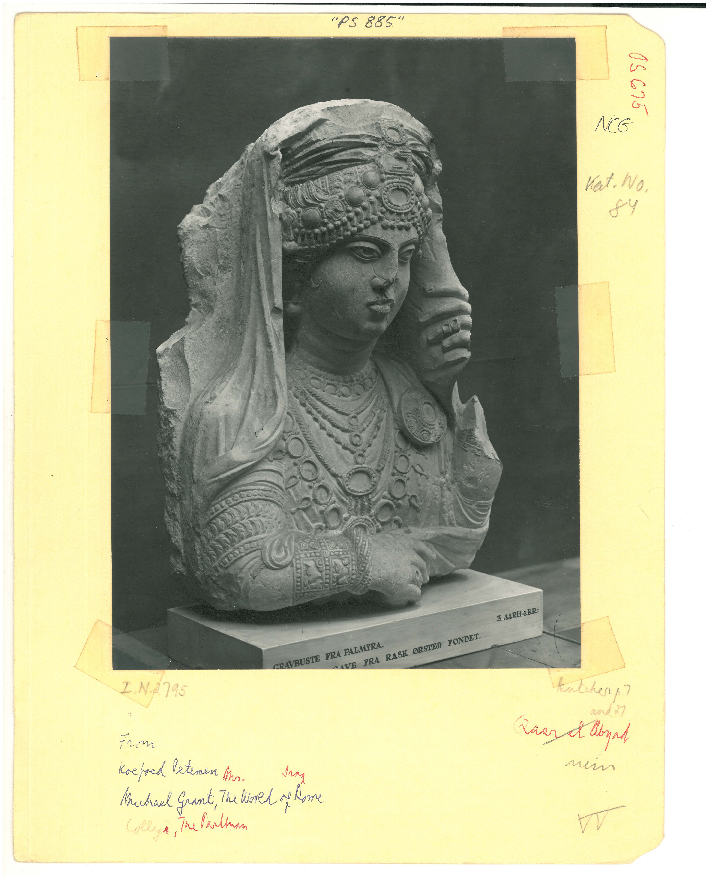In the Ingholt Archive
With the lifting of COVID-19 regulations, the Archive Archaeology project was able to visit the Ingholt Archive in person at the Ny Carlsberg Glyptotek in Copenhagen.


By postdoc Amy Miranda.
Over a year has passed since the project Archive Archaeology: Preserving and Sharing Syria’s Cultural Heritage through Harald Ingholt’s Digital Archives was initiated by Professor Rubina Raja and, despite COVID-19, the project continued in its endeavour to facilitate the preservation and dissemination of Syrian heritage through a digital medium. Although focused on Harald Ingholt’s archive in its digital shape, the project participants took a trip to Copenhagen to visit the Ingholt Archive in person for the first time since the project began.
Since 1983, the Ingholt Archive has been housed at the Ny Carlsberg Glyptotek where it is only accessible with permission from the museum. In 2012, the archive was temporarily transferred to Aarhus University where it was digitized within the framework of the Palmyra Portrait Project. The sheets, of which there are 2,347, have mostly been studied by the Palmyra Portrait Project as part of its objective to collect and publish all known Palmyrene funerary portraits. It has only been with the start of the Archive Archaeology project that the archive sheets have become an object of study in their own right. Archive Archaeology has focused on the potentials of the archive both in its physical and digital forms. In the project’s first year, all research was conducted using the digital archive, but this has now changed in the second.
On 6 October, project participants headed to Copenhagen to visit the archive. For some, this was the first time that they would see the physical archive in person. After intensive research and diligent preparation of the archive’s publication (Bobou, Miranda, Raja and Yon forthcoming) this was a very welcome experience. The trip began with a visit to the galleries to see some of the Palmyrene sculptures in the Ny Carlsberg Glyptotek’s collection, such as the so-called Beauty of Palmyra (Fig. 1), and then project participants were allowed ‘behind the scenes’ and into the archive. The archive sheets are stored in 19 blue folders on several shelves. (Fig. 2) It is unknown how the archive was organized when it arrived in Copenhagen, but the work of archaeologist Gunhild Ploug involved an extensive restructuring that is reflected in the present-day storage of the archive. The folders are mostly arranged by sculpture chronology though there are exceptions – some folders have labels that reflect a specific typology, while others are miscellaneous. One such miscellaneous folder, labelled ‘Palmyra 1’ was removed from the shelf for project members to look through.
There is a myriad of benefits to digital archives – the preservation of fragile material or the potential for wider dissemination, to name but two examples – but it was rewarding for project participants to physically touch the same archive sheets handled by Harald Ingholt after a year of rigorous research. As the scans of the archive sheets were made in 1200 dpi, every detail of the sheets is crisp and clearly visible, thus making them a valuable asset and they will soon be made available in PDF form (Bobou, Miranda and Raja forthcoming).
In addition to the project’s visit to the galleries and the archive, project director Professor Rubina Raja and postdoctoral fellow Dr. Amy Miranda were interviewed in the museum’s library by the ALIPH foundation. These interviews will be made available in coming months on the ALIPH Foundation’s YouTube page. Professor Raja and Dr. Miranda discussed the project’s first year and the forthcoming research anticipated in the second. In addition to discussing the archive sheets, Professor Raja spoke at length about the value of archives for the preservation of heritage, particularly in conflict zones, and the ways in which Archive Archaeology hopes to mitigate some of the losses of Syrian heritage due to the country’s now decade-long civil war.
For more about the project, see https://projects.au.dk/archivearcheology/
For the Palmyra Portrait Project, see https://projects.au.dk/palmyraportrait/
Bibliography
Bobou, O., A. Miranda and R. Raja. Forthcoming. “The Ingholt Archive. Data from the project, ‘Archive Archaeology: Preserving and Sharing Palmyra’s Cultural Heritage through Harald Ingholt’s Digital Archives’”. Journal of Open Archaeology Data.
Bobou, O., A. Miranda, R. Raja and J.-B. Yon. Forthcoming. The Ingholt Archive: The Palmyrene Materia, Archive Archaeology. Turnhout: Brepols.
